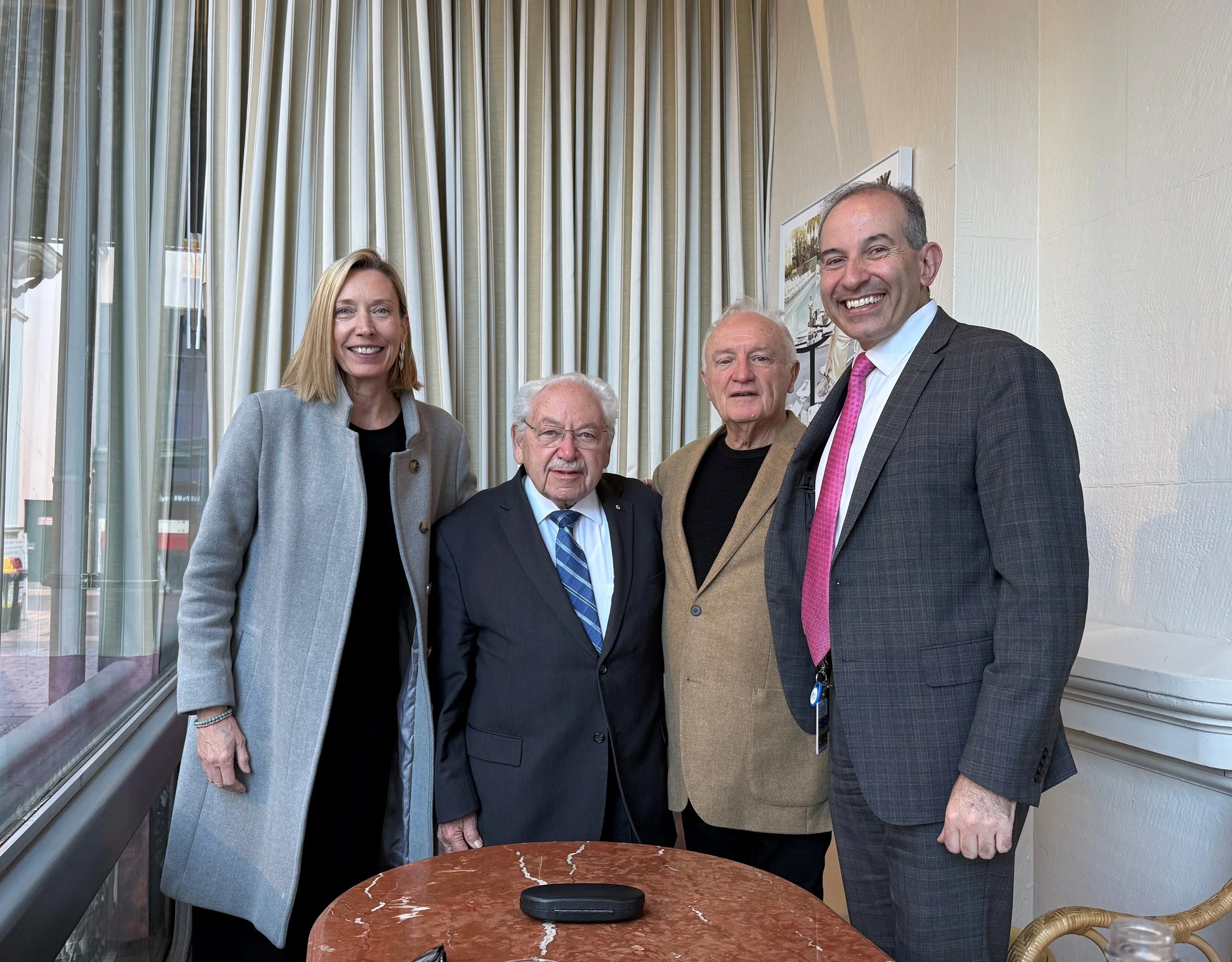Vision, Light & Gratitude: An Artist’s Afternoon With the Guardians of Australian Sight
Linda Fagen, Executive Director, Sydney Eye Hospital Foundation; Dr Lyon Robinson AM; Ralph Kerle; Dr Con Petsoglou (l-r)
This July marked 41 years since I received a corneal transplant in my right eye—a gift that allowed me to keep seeing the world in full colour, to follow light as it dances across water, and to become the artist I am today. The donor of my cornea was believed to be around 60 years old at the time, which means—remarkably—that I’m still seeing the world through an eye that’s now over 100 years old.
To honour that extraordinary milestone, I spent a beautiful afternoon with three remarkable people whose lives are intertwined with mine in profound ways:
Dr. Lyon Robinson, AM, the eye surgeon who performed the transplant all those years ago.
Professor Con Petsoglou, my current ophthalmologist and now the head of the NSW Eye Tissue Bank.
Linda Fagan, Executive Director of the Sydney Eye Hospital Foundation, whose work helps drive and fund the research that enables and advances life-changing procedures like mine possible for thousands of others.
It was a meeting filled with warmth, laughter, and gratitude—and at times, emotion. Because this wasn’t just a celebration of the past, but a glimpse into a future where the gift of sight will be available to even more people through continuing medical innovation and human generosity.
Why This MEETING happened
Our meeting took place just as DonateLife Week 2025 (July 27 – August 3) was beginning. This national campaign encourages Australians to consider becoming organ and tissue donors—a gesture that can change or save up to nine lives, including restoring sight through the donation of corneas.
As someone who received a donor cornea in the early 1980s, this week holds particular meaning. My transplant took place during a time when donated tissue had to be used within just 48 hours. That meant doctors like Dr. Robinson were often called in late at night, rushing into surgery to make the most of a rare and precious gift.
Today, thanks to improved preservation techniques and screening, donated corneas can be stored for extended periods up to 14 days and shared across states, giving even more people the chance to see clearly again.
A Moment 41 Years in the Making
Dr Robinson (l) with Dr Petsoglou (r)( viewing archives of the record of every single corneal transplant completed in New South Wales since 1972
Sitting across the table from Dr. Robinson—now in his late 80s and still full of warmth and wisdom—I was able to thank him in person for restoring my sight. He recalled the era when eye surgery was still evolving and spoke modestly about the care and precision it took to ensure each transplant succeeded. Remarkably, he told us he’d never had a stitching failure during his entire career, a very delicate part of the operation when attaching the donated cornea to the eye surface.
Professor Petsoglou, who now leads the NSW Eye Tissue Bank, spoke about the responsibility of selecting and testing donor tissue—a meticulous and evolving science. What struck me most was his acknowledgement Dr. Robinson was his and many other Australian eye surgeons original mentor. That legacy continues in the eyes and lives of countless Australians.
The Hazen Film: Sight, Art, and Understanding (To be released Spetember 1 2025)
Post our informal coffee meeting, we visited the premises of the NSW Eye Tissue Bank and along with its senior management viewed a short film produced by Hazen Digital that follows my artistic journey and the profound effect this corneal transplant has had on my work. The film explores how my sight was reshaped by keratoconus—and how that condition left a lasting imprint on the way I see and represent the world around me.
The distortions I once saw—ripples, ghosting, softened edges—still echo through my abstract photographs, even though my vision has long since been restored. Watching the film was a powerful reminder of how personal vision truly is.
Final Reflections
Art begins with light. And light begins with vision.
For 41 years, I’ve been lucky to have that light flood in through a donated cornea. It has shaped how I see the world—and how I show it to you through my work. I owe that to a stranger I never met, and to a surgeon who made sure the light reached me.
I want to thank Dr. Robinson and Professor Petsoglou for their lifelong dedication to restoring sight and for sharing this meaningful afternoon with me. Their work—quiet, persistent, and generous—is what allows artists like me to keep seeing, keep creating, and keep believing in the beauty of human connection.
I hope you enjoy the photos and take a moment to watch the film.
How You Can Help
If this story moves you, please consider taking a moment to register as an eye or tissue donor. It’s simple, takes less than a minute, and could one day restore the gift of sight to someone like me. You can find the official registration link on the DonateLife website (donatelife.gov.au).
And if you’re already a registered donor, let your loved ones know—it’s one of the most important conversations you’ll ever have.
With gratitude,
Ralph


